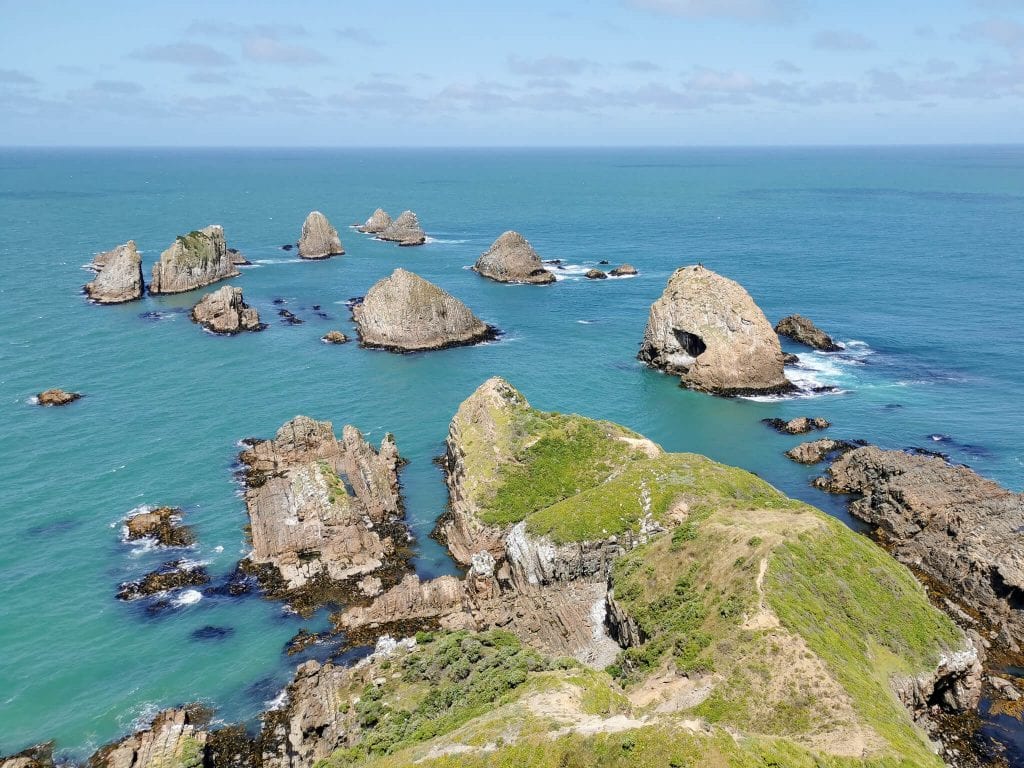
The Southland region is an epic destination to explore. If you’re keen to learn more about this unique and beautiful region at the bottom of the South Island, this article will fill you in! Discover some of the best things to do in Southland, views that are out of this world and unique attractions recommended by a local Southlander Alice– A NZ hiking and outdoor expert who was raised on a sheep farm in deep Southland.
Keep in mind this post contains affiliate links. If you purchase anything through them, I will get a small referral fee and you will be supporting me and my blog at no extra cost to you, so thank you!
Southland has some of the most pristine untouched wilderness that New Zealand has to offer and is home to the friendliest locals and the coolest wildlife (in my opinion). Want to discover stunning scenery that will blow your mind? See glow-worms for free? Spot a kiwi in the wild? View one of the world’s rarest penguins? You’ll find it all in Southland baby! Let’s get this show rolling!
Below are 7 incredible things to do in Southland!

1. Visit Milford Sound
Milford Sound was named the “eighth wonder of the world” by Rudyard Kipling and it’s pretty clear why the name stuck. If you haven’t been – imagine soaring bluffs starting from below the surface of the fiord and stretching all the way up to a kilometre plus above the water, absolutely dwarfing the boats cruising along their base; so high you have to crane your head up to see their summits.
Imagine ridiculously lush waterfalls catapulting off the cliff-tops and dancing their way down the walls, while dolphins, penguins, and seals play in the waves. The smell of salt on the air, the sound of waves, wind lifting your hair, freedom. That’s Milford Sound. It’s another world.
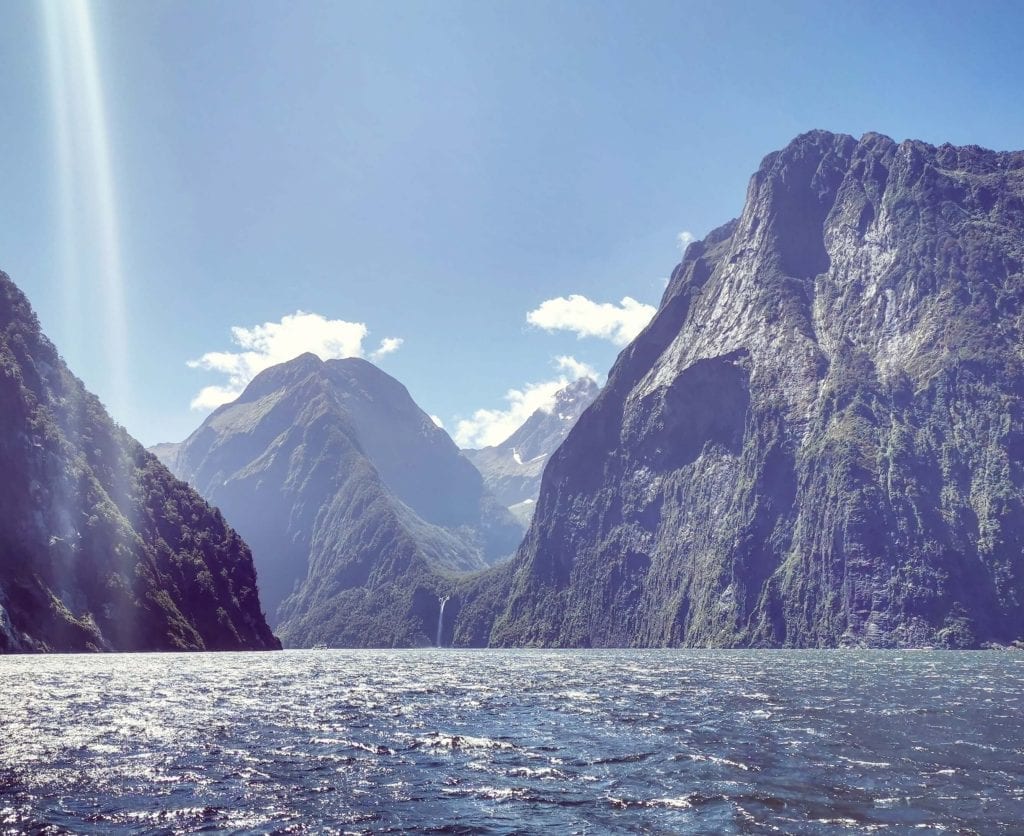
On any visitor’s itinerary, Milford Sound is an absolute must-see. But what to choose? A flight? Kayaking? A cruise? It all comes down to personal experience, so if there’s something you’ve had your heart set on experiencing – then book it!
If you’re not too sure then consider the following. Flying into Milford is breathtaking, but so is the price tag. Instead, my personal favourite and quite possibly one of the best things to do in Southland is either a Milford Sound cruise or Milford Sound Kayaking (depending on your fitness level and preference). Kayaking is a really awesome choice as you get a sense of the scale of the fiord from the level of the water, something that can be lost from the air.
Although many of these types of tours are considered “tourist traps” by New Zealanders, Milford Sound is the exception to the rule in my opinion (this coming from someone who grew up only a few hours away) and a cruise or kayak is well worth the price tag and one of the best things to do in Milford Sound. Not only will you get gorgeous views, your tour guide or captain will tell you all about the wildlife you encounter, as well as the varied history of the fiord (including its importance for Māori as a source of pounamu / jade).
Below are a few different cruise options for you:
- Milford Sound overnight cruise
- Milford Sound nature cruise
- Quite possibly the best Milford Sound cruise
Other activities you might like to try in Milford Sound:
- Looking for a day trip? Check out this Milford Sound day trip from Queenstown
- Milford Sound helicopter trip with 2 landings
- Milford Sound scenic flight from Queenstown

Driving along the Milford Road
Driving to Milford Sound is in and of itself one of the most incredible things to do in Southland. Check out some of the best stops along the road below.
- Mirror Lakes
- Key Summit
- The Chasm
- Lake Marian – (An awesome Milford Sound hike)
- Gertrude Saddle
- Homer Tunnel
- Eglington Valley lookout
- Monkey Creek (beautiful views + fresh pristine water to fill up your water bottle)
- Falls Creek Falls (Christie Falls)
Related Post: Driving from Queenstown to Milford Sound in a day
Milford sound accommodation options
There is only one public accommodation option in Milford itself which is the Milford Sound Lodge. Your other options include camping along Milford Road. There are 8 Department of Conservation campsites along Milford Road. View the DOC camping options here.
I recommend staying at one of the many accommodation options in Te Anau or for a little more peace and serenity I recommend Manapouri. – If you are looking at going to Doubtful Sound then you will likely want to stay here before or after.
Below are a few different accommodation options for you around Milford Sound.

- Fiordland Lodge is a luxury accommodation option looking over Lake Te Anau and the surrounding mountains. They have a restaurant, open architecture and are well known for their impeccable hospitality.
- Fiordland Lakeview Motel and apartments are located on the shores of Te Anau with beautiful gardens and only a 10 minute walk from the town centre.
- Te Anau lakefront backpackers is located on the lake front only 5 minutes walk from the town centre. Apart from dorm beds they also have glamping and camping options!
2. Visit Doubtful Sound
Doubtful Sound vs Milford Sound
So if Milford Sound is the eighth wonder of the world, then Doubtful Sound is Milford’s less busy, but no less photogenic, cousin. Because it’s more difficult to access it’s often slightly more expensive, which can put people off.
If you are wondering whether to pick Milford Sound or Doubtful Sound I would suggest Doubtful sound as it has all of Milford’s glory, but more serenity. I still haven’t experienced an overnight cruise on Doubtful Sound, but it’s on my wishlist for this year or the next!
Below are 2 different Doubtful Sound cruise options for you:
Other activities you might like to try in Doubtful Sound:
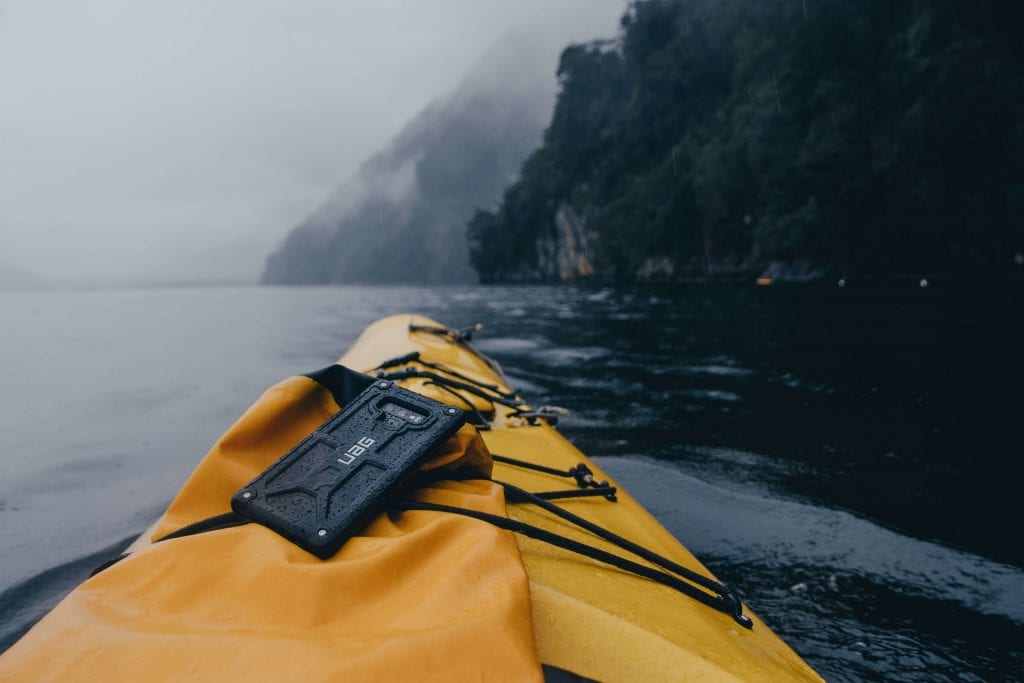
Fiordland Weather
The one challenging thing about Fiordland in general (other than the sandflies – bring strong repellent!), is the weather. To say that it “often rains” is an understatement.
Milford Sound is one of the wettest places in the world, and it rains on average almost 200 days of the year, with an average rainfall of ~6,800mm. So be prepared to get wet. That might sound off-putting, but Milford Sound is at its best when it’s moody and the cliffs are coming alive with waterfalls – something that is lost when it’s sunny. The absolute best time to visit is right after the rain, just as the sun is starting to peek out from behind the clouds and illuminate the water – but that comes down to luck my friends.

To make sure you understand the changeable NZ weather conditions and for everything you need to know including a FREE first aid kit packing list grab your NZ Outdoor safety guide below!
3. See the Southern Lights
The Aurora Australis (also called the Southern Lights) is an amazing natural phenomenon that can only be experienced in a select few places in the world. New Zealand is one of those places thanks to its high latitude (being close to Antarctica and the South Pole) and is a lot more accessible than many other locations.
I’ve seen the southern lights NZ twice in my lifetime; once by chance in Southland as my family was driving home at night and the sky lit up with a light show I’ll never forget, and once on purpose with a group of photographers in Christchurch, Canterbury, although it wasn’t easily visible to the naked eye that far north. The further south you get, the more chance you have of catching the aurora – so Southland is a great place to go aurora hunting!
My pick of the best spots for seeing an aurora in Southland would be:
- Steward Island: the southern-most populated part of New Zealand, although it’s unlikely you’ll have a problem with light pollution as there are only ~400 inhabitants
- Oreti Beach: a 10-minute drive from Invercargill
- Catlins: more remote, although you can book a crib (Southland slang for holiday house) right on the beach at Curio Bay
- Bluff Hill: almost the South Island’s southernmost point looking towards Stewart Island
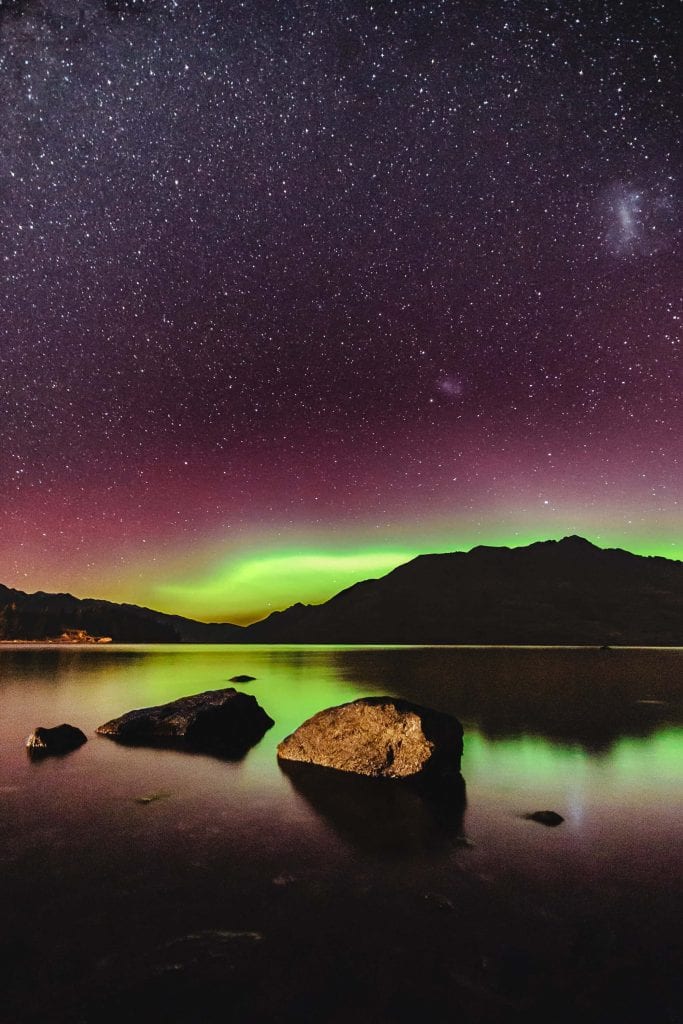
It’s not at all guaranteed that you’ll see an aurora on you trip. But here are some tips to help:
- The Southern lights are more easily seen during the winter months (because the increased hours of darkness give you more chances to see them)
- You need to be facing south
- You also need to be away from other sources of light pollution (such as cities or towns, or the light of a full moon)
- The sky needs to be clear of clouds
- The beautiful green, blue and pink colours are not often visible to the naked eye and only show up on camera, so if you’re not into astrophotography watch for a grey light on the southern horizon (or if you’re lucky, all across the sky) that moves as though it’s dancing to silent ethereal music
- The aurora doesn’t happen very often – check out the KP forecast (measuring sunspot activity) via a quick Google search, or join one of the many Facebook groups that alert members to aurora activity
Bundle up warm and best of luck!
4. Chase waterfalls and view wildlife along the Catlins coast
The Catlins is a gorgeous part of New Zealand that is often overlooked by tourists, despite being renown for its lush waterfalls, beautiful beaches, and abundant wildlife. However, for locals and the smart visitor, this oversight is a positive – it means you get to enjoy one of the most stunning Southland attractions with no crowds!
Whilst you won’t see any multistorey hotels in the Catlins, you will see untouched, almost empty beaches, cascading waterfalls, and (if you’re lucky) some penguins, seals, or dolphins that call the Catlins home all along the southern scenic route.

There are lots of places worth visiting, but my pick of the best things to do in the Catlins are:
- Purakaunui Falls: just a 10 minute walk from the carpark to a stepped waterfall with viewing platforms at the top and bottom of the falls.
- McLean Falls: a 40 minute return walk to a higher cascade
- Cathedral Caves: soaring sea caves accessible only for 3 hours around low tide. Visitors cross land that is cared for by Māori, and a $10 charge per adult applies for the use of carpark and walkway.
- Curio Bay: a petrified forest (fallen logs that have turned to stone, you can still see the wood grain in the logs) as well as a nesting place for one of the rarest penguins in the world; the Hoiho or yellow-eyed penguin. On the more sandy side of the point, dolphins can often be seen playing in the waves.
- Nugget Point: a 15 minute walk to Tokata lighthouse with an amazing view over the “nuggets” – an interesting seascape, as well as views down on stony beaches filled with seals and their pups.
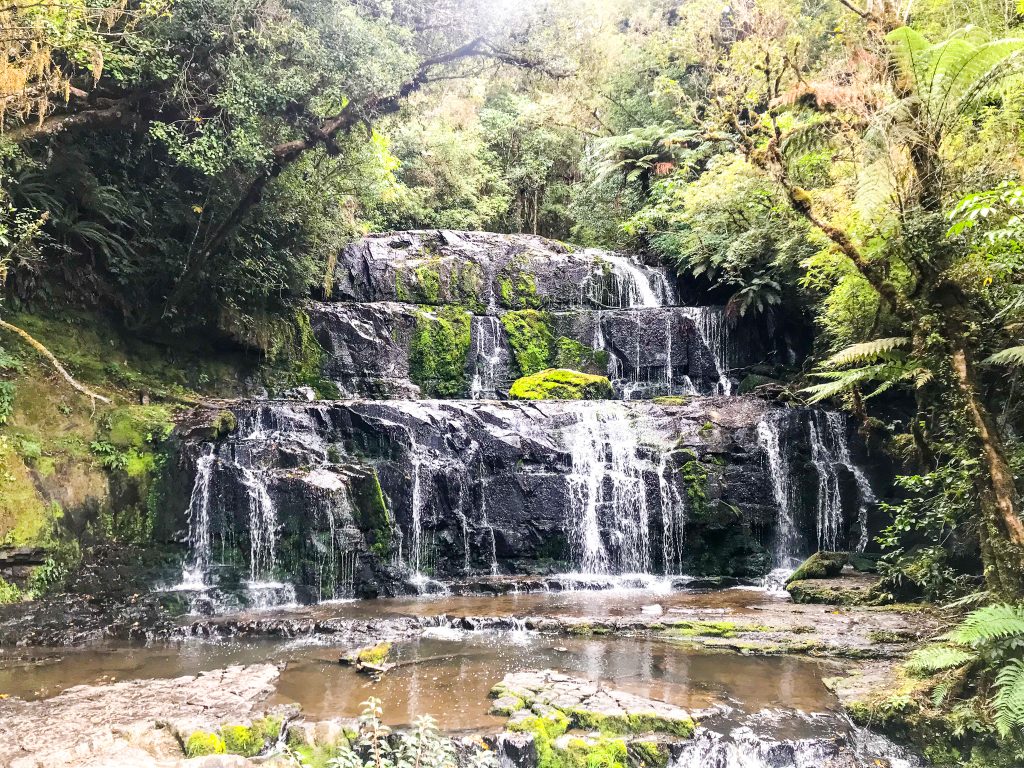
5. Tramp (hike) one of the New Zealand great walks
You don’t go hiking in New Zealand – you go “tramping” and there are plenty of tramping tracks to choose from, particularly in Southland! I may be a bit biased (I do write a tramping blog), but tramping / hiking is a great way to experience New Zealand’s unparalleled beauty. But which ones to choose?
Pro tip: Download the free hiking checklist below for an ultimate checklist of items you need to take with you hiking in New Zealand!
The form you have selected does not exist.
The most famous of New Zealand’s tramps, are those that have been designated “Great Walks NZ” – a bit of a misleading title, since they’re certainly not a walk in the park.
At the time of writing, there are currently 10 great walks in NZ, with a disproportionate four of the ten being in Southland! The Milford, Routeburn, Kepler, and Rakiura tracks. The Hump Ridge Track, also in Southland and run by a local charitable trust, will join as a Great Walk in 2022.
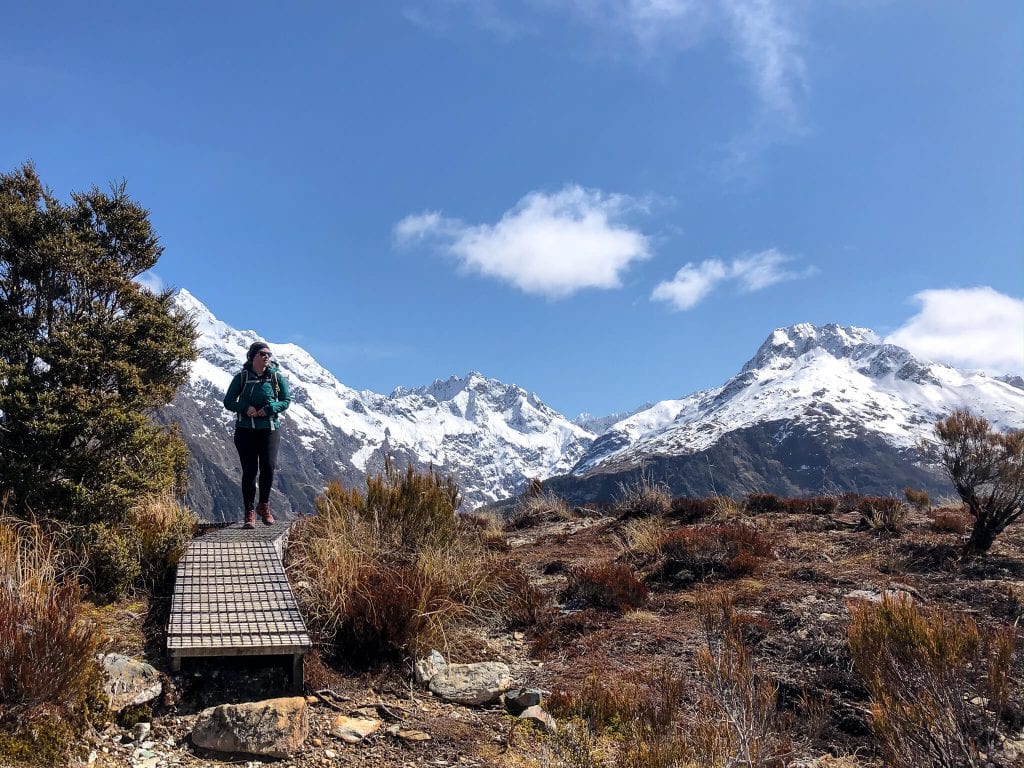
All of the Great Walks need to be booked in advance for the summer season (which is often the only safe time to complete them due to avalanche danger in the winter and early spring) and they often sell out well in advance.
You can book them on the Department of Conservation (DOC) website here. All of the Great Walks are multi-day trips, so unless you’re paying for a guided walk, you have to be entirely self-sufficient – the only amenities in the huts are gas for cooking, running water (not always potable), a fire for heating, toilets, and communal bunk beds.
All of the Great Walks are amazing adventures, but my personal favourite is the Routeburn track. In my opinion there isn’t a better experience than breathing in fresh mountain air, looking around at amazing views that you’ve puffed and sweated to reach (and eating hard-earned chocolate).
For more New Zealand tramping / hiking information and inspiration, check out my blog: aliceadventuring. Feel free to reach out if you have any questions!
6. Spot kiwi on Stewart Island
Kiwi birds are emblematic of New Zealand and its people – so much so that we are called Kiwis rather than New Zealanders. You can sometimes see kiwi in zoos or wildlife sanctuaries, but seeing a kiwi in the wild is very rare – not many New Zealanders can even boast of experiencing that in their lifetimes!

So where can you find kiwi in the wild? One of the best places to spot wild kiwi is on Stewart Island / Rakiura; New Zealand’s third island, just south of Invercargill. There are many different species of kiwi, but the biggest is the Rakiura tokoeka found on Stewart Island.
The remote Mason’s Bay on Stewart Island has the largest known population of Rakiura tokoeka, but it isn’t easily accessible. You can charter a flight (which lands on the beach) and stay the night in the hut there, or do a combination of tramping and water taxi-ing to get there.
When I was there a few years ago, I had kiwi come right up to the deck of the hut to investigate – so it’s well worth it! The other options for seeing kiwi on Stewart Island are booking a guided tour from Oban, the only village on the island, or taking a stroll around the bush at night with your fingers crossed.
Tips for spotting kiwi:
- Kiwis are nocturnal animals, so it’s extremely rare to see them during the day – they normally come out at dusk.
- Move quietly with minimal talking while out searching (wear clothing that doesn’t make lots of noise).
- Listen for the sounds of kiwi bushwhacking their way through the undergrowth – they’re surprisingly loud!
- Use a red light (this doesn’t disturb the birds and maintains your night vision) and avoid flash photography.
- If you see a kiwi don’t approach and maintain a safe distance of at least 1-2 metres.
- Never touch a kiwi and don’t follow them into the bush – you may disturb their nest.
- If you see signs of kiwi activity during the day (kiwi tracks, holes in the ground, disturbed undergrowth), take note and go back to that area at sundown. Kiwis can be found in both the bush, and on beaches.

How to get to Stewart Island
Either catch the Stewart Island Ferry that leaves from Bluff or a Stewart Island flight that departs from Invercargill. There are also coach and ferry options from Invercargill, Queenstown & Te Anau.
7. See glow-worms for free at the Clifden Caves
New Zealand has quite a few cave systems where you can see the beautiful blue lights of the glow-worms, but often you have to pay top dollar for a guided experience. Not so in Southland! The Clifden caves are a bit of a locals’ secret, and they’re also completely free and one of the more unknown things to do in Southland!
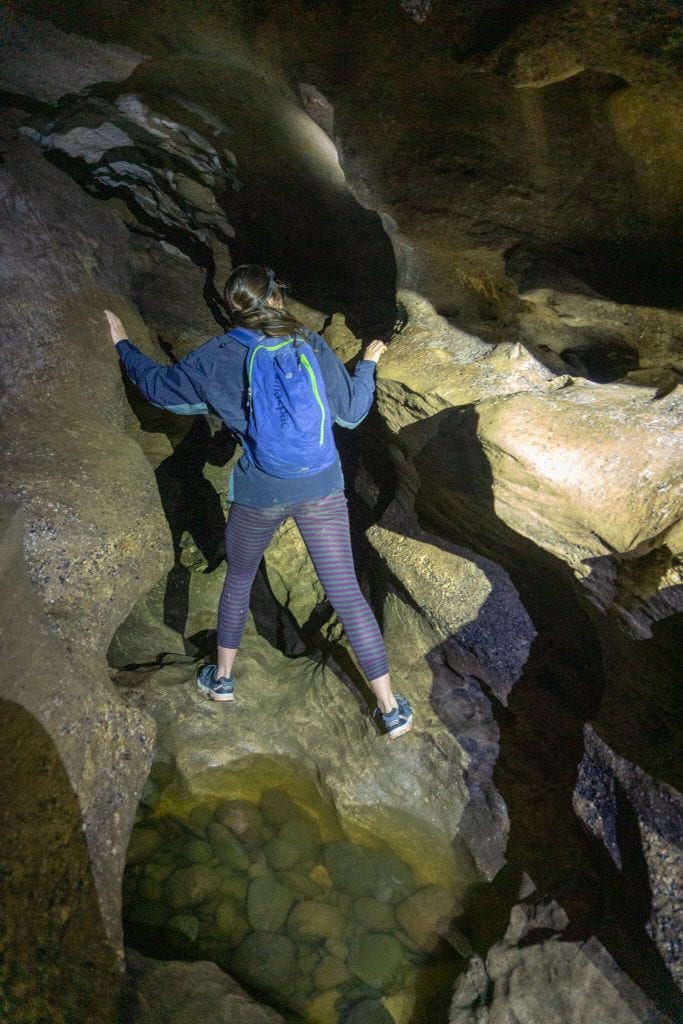
The Clifden caves are on the back road to Manapouri, and so are perfect for adding on to an itinerary to Te Anau or Milford Sound. This is a self-guided trip, so you need to be prepared to be underground for 1-2 hours, which includes getting wet and climbing up / down ladders.
I recommend taking the following with you on your adventure:
- A headlamp as well as a backup (not your cellphone or camera)
- Fast-drying, warm clothes you don’t mind getting dirty and wet (that means no cotton or jeans as these stay wet and cold)
- Non-slip footwear with ankle support – water-proofing doesn’t matter as the water can be over your ankles
- Some snacks (if you’re like me and need chocolate on your person at all times)
- A waterproof bag to store your phone/camera / back-up torch
- A helmet if you’re accident prone – there are low ceilings and one or two crawls, so head protection is recommended
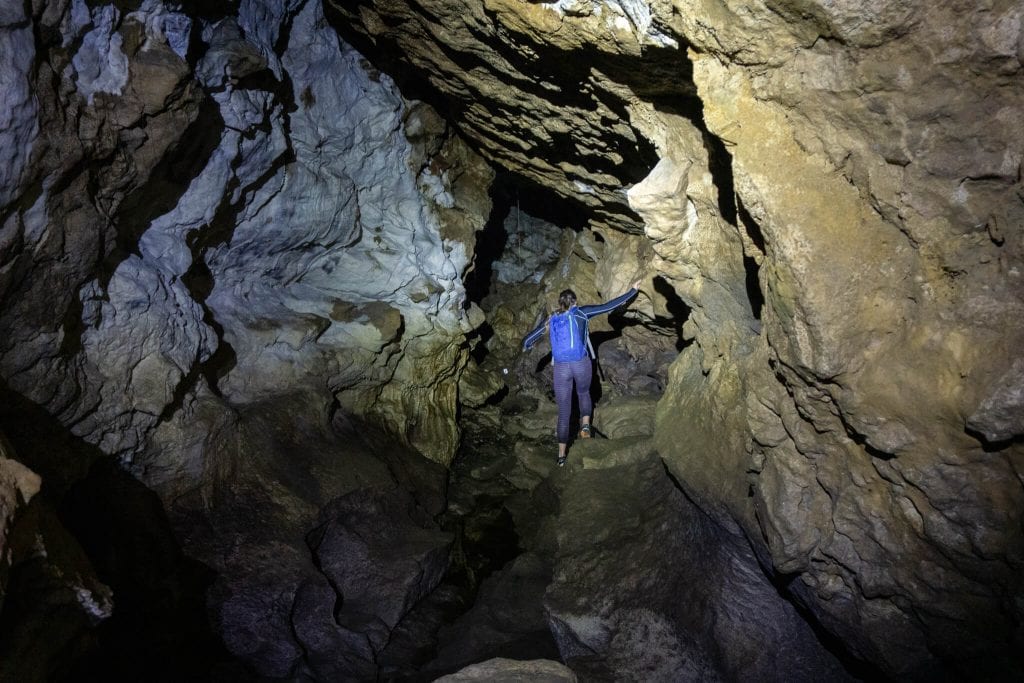
The cave system is prone to flash flooding so do not enter before, during or immediately after heavy rain. If you want a complete walk-through of the Clifden Caves including how to get around the “swimming pool” without falling in, then check out my blog post about Clifden Caves.
So have I convinced you to move to Southland yet? Or at least visit? This is only a small example of what Southland has to offer – it’s a pretty special place. Let me know if you’ve got any questions, Lee and I both love to help people make the most of their New Zealand holidays.
Loved this article on incredible things to do in Southland? Pin the images below for later!
Other articles you might like:





The photos look so amazing. Can’t wait to get out and explore our backyard again.
Hey Matt! Thank you. Nature did all the work haha! Me either, it’s going to be like a new found freedom. Enjoy!